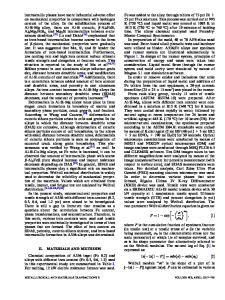Effect of carbon equivalent on thermal and mechanical properties of compacted graphite cast iron
- PDF / 903,216 Bytes
- 8 Pages / 584.957 x 782.986 pts Page_size
- 95 Downloads / 369 Views
Tao School of Materials and Chemical Engineering, Xi’an Technological University, Xi’an, Shaanxi, 710021, People’s Republic of China (Received 3 April 2016; accepted 24 June 2016)
The effects of carbon equivalent on thermal and mechanical properties of compacted graphite cast irons were investigated at ambient temperature, 300 and 500 °C, respectively. The group implied the change of carbon content to control the carbon equivalent. The results indicated that with the increasing carbon equivalent from 4.43 to 4.74, the graphite count increase. The thermal conductivity was 48.64, 44.55, 49.04, and 50.36 W/mK for carbon equivalent about 4.43–4.74 of compacted graphite cast irons at ambient temperature, respectively. With an increase in temperature, the thermal conductivity decrease. Moreover, with the increasing carbon equivalent, the tensile strength and yield strength increase initially, and then decrease at ambient temperature, 300 and 500 °C, respectively. With an increase in temperature, the tensile strength and yield strength decrease. Characterization of fracture surface indicated that the mixed ductile-brittle fracture mode prevailed in the compacted graphite cast irons with different carbon equivalents. I. INTRODUCTION
The graphite morphology of compacted graphite cast iron (CGI) is a short, stubby, and wormlike form with rounded edges.1–3 Owing to this type of structure, compacted graphite cast iron possesses special properties that are intermediate between gray and ductile cast iron. Previous works4–7 have indicated that, the preparation of compacted graphite cast iron produce less dross and less susceptible to shrinkage porosity and carbide formation. Moreover, the strength, ductility, and toughness of compacted graphite cast iron are superior to gray iron and approach those of ductile iron. The thermal conductivity and damping capacity of compacted graphite cast iron are better than ductile iron. Based on aforementioned results, the compacted graphite cast iron, stemmed from the good combination of thermal and mechanical properties, is an excellent candidate in numerous industrial applications, such as ingot molds, brake drums, and cylinder heads.8–10 In the past decades, particular emphasis has recently been placed on the improvement of mechanical properties of compacted graphite cast iron.11–20 The study by König et al.13 have showed that Mg has a significant influence on the graphite morphology, which causes a substantial Contributing Editor: Jürgen Eckert Address all correspondence to these authors. a) e-mail: [email protected] b) e-mail: [email protected] DOI: 10.1557/jmr.2016.263
increase in nodularity. On one hand, Cu, Si, and Sn only cause change slightly in the nodularity. On the other hand, Cu, Si, and Sn can affect significantly the mechanical properties primarily via altering the pearlite content of a material. Cr and Mo facilitate the formation of carbide and therefore increase the mechanical properties of compacted graphite cast iron. Shy et al.16 have reported the effects of titanium addi
Data Loading...










